Winter Math Carnival Adds Up to a Good Time for Local Families
I think this can be a powerful experience for kids who already really like math, but especially kids who are maybe struggling with that and don't think they're good at math to be able to come and have success and fun doing math. I think that can be a really powerful experience. – Elizabeth Field
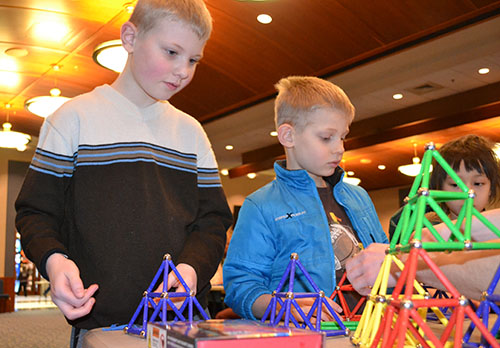 Young visitors create fractals during the Winter Math Carnival.
Young visitors create fractals during the Winter Math Carnival. 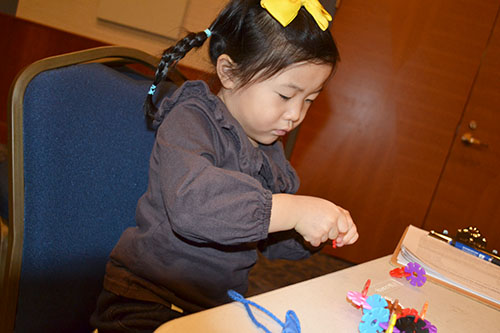 A young visitor does a hands-on activity during the Winter Math Carnival.
A young visitor does a hands-on activity during the Winter Math Carnival. February 12, 2020
Math can be fun! This was the idea behind the Winter Math Carnival held at the Alice Campbell Alumni Center on February 2nd from 2:00–5:00 pm. It drew around 150 families and 400–500 people overall—parents, grandparents, and a whole lot of kids having a good time. Sponsored by Illinois Geometry Lab (IGL), a key research/outreach program of Illinois’ Mathematics Department, the carnival featured a variety of hands-on, math-related activities and games that encouraged the youngsters to think. Plus, in addition to some goodies, kids had a chance to interact with math students who were eager to share their passion for what they do and how much fun math can be.
Organizing the event were a couple of Illinois Math PhD students. For instance, Simone Claire Sisneros-Thiry got involved because she was the graduate leader for IGL’s development of exciting outreach material. Her fellow co-coordinator, Elizabeth Field, has served as a mentor for a couple of undergraduate student research projects. Of course, the Director of IGL, Math Associate Professor Philipp Hieronymi, was also integrally involved.
In fact, one of his duties was advertising the event. The IGL sent tons of flyers to area schools for students to take home to their parents. It was also advertised electronically: through websites like chambanamoms.com, a community website of family-friendly activities, and on Facebook, and also on the math building’s rotating screens.
Regarding the overarching goals of IGL’s large outreach events, Hieronymi has been trying to connect to the historical/social context of math. For example, a couple of years ago, their winter math festival celebrated the 40th anniversary of the Four Color Theorem, proved here at Illinois. Similarly, this year’s carnival was in honor of Julia Robinson, the first female president of the American Mathematical Society, who would have turned one hundred in December. So the goal was to do activities related to the type of work she did: logic, algorithms, and a little bit of computation.
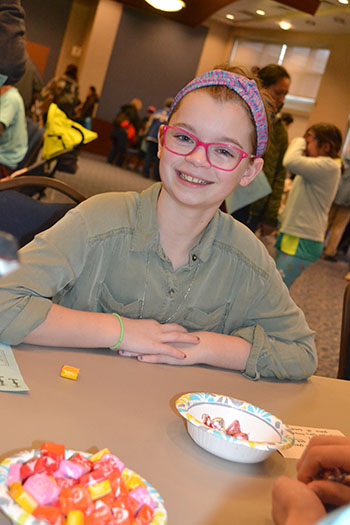 A local middle schooler enjoys one of the carnival's candy games.
A local middle schooler enjoys one of the carnival's candy games. The plethora of events came from several different sources. Field worked with students in two of IGL’s undergraduate research groups, whose mission was to develop several exciting outreach activities for the carnival. “Sort of the whole goal for those idea projects last semester was to develop activities for this event. And so the students, I think, are really excited about getting to the actual kids.”
Staffed by 20 or more math graduate and undergraduate students, the event featured loads of fun games, including Color Rules; Hexaflexagon; Frogs and Toads; Fun with Sorting Algorithms; Fractal Patterns & Iterations; Who Took the Candy?; Chocolates & Chili; Kisses and Starbursts; a math maze, Jumping Julia, and more.
While most activities were created locally for the carnival or from previous math events, organizers also borrowed a few from a national organization, Julia Robinson Mathematics Festivals, which publishes lots of activities on their website, from which IGL outreach teams have borrowed on occasion. However, Math’s Carnival was not affiliated with the national organization in any way.
What were the activities and games like? Some of Simone’s favorites were those that dealt with candy, such as: Who Took the Candy; Chocolates & Chili; and Kisses and Starbursts. “You have a pile of candy,” she explains, “and then there are rules about how many you can take away. So if I'm playing with Elizabeth, I can take one and then she could take one or two and then I could take one or two, and you try to develop a strategy.” And lest the youngsters succumb to temptation and eat some of the “playing pieces,” there was other candy for the kids to eat, which Simone agreed was very important.
About the different candy games, Simone continues: “What I like about that is that it's something where the rules are fairly simple, but they can be modified. And it's something that people can take home.” While they had participants use chocolate kisses or starbursts, she says folks could use whatever they have on hand at home, such as pennies. “I hope people will play these games, and then maybe go play again at home with an adult or with another friend,” she adds.
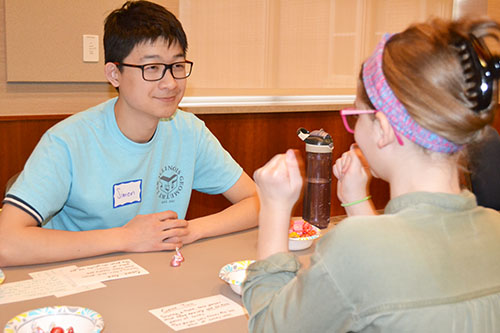 A math student, Simon Liu, interacts with a middle school visitor to the carnival.
A math student, Simon Liu, interacts with a middle school visitor to the carnival.A game Elizabeth Field was particularly excited about was Color Rules, which comes from color logic rules. Here’s how it works. The player starts with a block of a particular color, say blue for instance, then is given various rules to follow, such as, Blue changes to red. So the player exchanges their blue block for a red one. While that was pretty simple, the rules can get more complex, such as You can change a blue block to red or you can change it to a blue block plus a green block. “The idea is to get the kids to think about what sort of color combinations can they come up with with this given set of rules.”
Adds Field: “And so this has a lot of applications to logic and finite state automata and generating languages.” Since this game is all about rules, it encourages students to play around with some of these rules. “That is mathematics we work with every day in a very fun and accessible way. It doesn't seem like math.”
One cool thing, according to Field, is that after participants have gone through the rules provided with the game, they can then say, “Okay, well, I want to make my own rules. I'm going to start with an orange block, and I'm going to have rules that say I can either take the orange block and add a gray block or whatever.” So the kids can play around and see what they can come up with. “Or if they want to come up with a particular string, will their rules let them get there? And so that's what we want them to be thinking about: what rules can they maybe come up with to get to a particular result?”
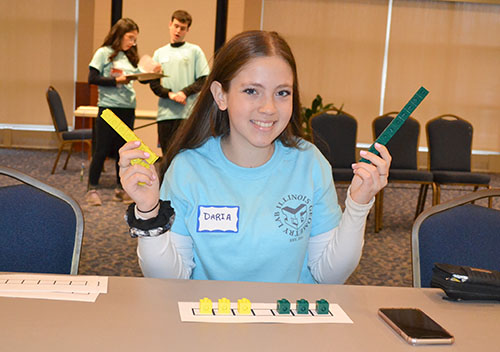 Math student Daria Chudnovsky running the Frogs and Toads game.
Math student Daria Chudnovsky running the Frogs and Toads game. So how did the frogs and toads game work? As can be seen in the photo to the left, at the start of the game, the yellow frogs are on the left, and the green toads are on the right. What the player must do is get all of the frogs to the right, and the toads to the left. However, the player can only move one piece at a time, moving one piece from right to the adjacent empty space on the left, or can jump over one piece in any direction to an empty spot. (This reporter tried for about ten minutes. After starting over several times, I decided a strategy was in order. However, realizing that I had a choice between doing Frogs and Toads the whole time, or getting photos and interviews, I chose the latter! Later on though, I briefly watched a kid who had figured it out, get all of her toads to the left and all the frogs to the right. Shamed by a third grader!)
For Field, the goal of the carnival was to “reach out to the community and show the families and kids in the community what cool things there are in math, and to engage them in thinking about problems they wouldn't necessarily think about in the classroom environment.” In addition, she hoped to “get them excited about math” by providing “a really cool, fun experience surrounding math that sort of can frame how they think about math as they progress in their education.”
In another fun activity, shapes were printed out on paper, and participants had to fold the paper so they could cut out the shape with a single cut: a straight line. While some simple geometric shapes, such as a square or a triangle were available, there were also some very complicated ones, such as the number eight.
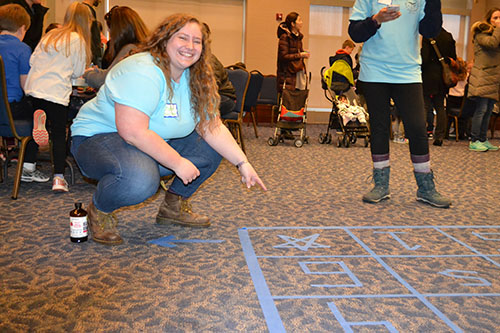 Maddie Farris points to the finish of the Jumping Julia game.
Maddie Farris points to the finish of the Jumping Julia game.Another popular activity was a math maze called Jumping Julia. Running the event was Maddie Farris, a first-year math PhD student, and the research manager for the IGL. She shares why she wanted to be involved with the carnival.
“I love working with math with younger students. I love trying to engage them in bigger math problems they wouldn't normally encounter, but in a friendly way. I think it's very fun.”
Here’s how Jumping Julia worked. The math maze was a 7´x7´ (also a 5´x5´) square with a number on each 1´ square. There was a starting spot; the finish was a square with a star. The starting square had a number; players could either move that many squares forward or that many squares to the left (only vertical and horizontal, not diagonal). When he or she landed on another number, that's how many squares they were allowed to move. So, a player who landed on a three could move three spaces in any direction. Plus, the player could never exit the maze. So if he or she landed on a square on the very edge, say on a five, they couldn’t go any direction that would take them off the maze.
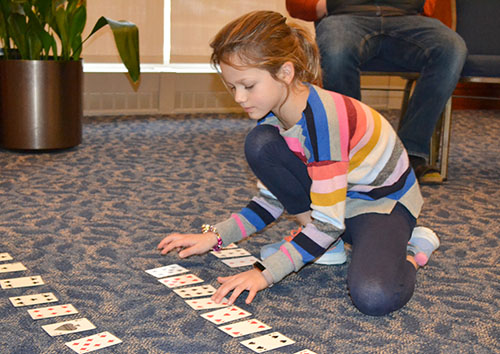 A young visitor works on the algorithm activity.
A young visitor works on the algorithm activity. 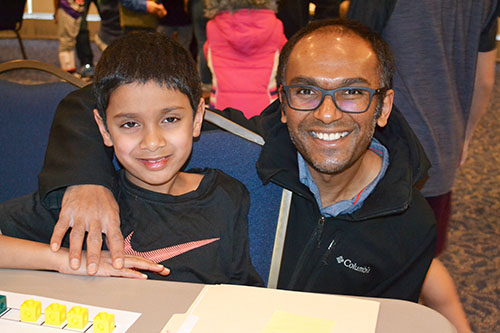 Sandeep Pulluru (right) and his son enjoying the carnival.
Sandeep Pulluru (right) and his son enjoying the carnival. “Those are all the rules,” Farris explains. “Turns out to be extremely difficult. Nobody's solved this maze yet.” She adds that they had numerous kids solve the smaller, 5´x5´ maze, which she calls “a little bit more straightforward.”
How long kids visited the various stations depended on how many folks were there at a given time, and thus, how long the lines were. While some kids tried to visit all the booths and go through them really quickly, if a kid really got into a certain game, they might stay at a booth for 30 minutes or more. For example, in the building fractals with magnets activity, several boys seemed to stay for close to an hour, just creating colorful fractals.
Activities were designed to be accessible for elementary school kids around third through eighth graders. For example, the algorithms team had watched a Netflix documentary about algorithms, and tried to use the resources out there to come up with an activity appropriate for third graders or for sixth graders.
Though activities targeted elementary school kids, a wide age range of folks showed up at the event, from infants (no doubt accompanying their siblings), to senior citizens (probably there to enjoy watching their grandkids do the activities). Adults were welcome to try the activities, and even toddlers seemed to have a good time.
Regarding younger kids, Simone suggested that though some of the activities could be “stuff that they might not understand, such as all of our algorithms,” she adds, “but they'll still have fun playing around.” And while they might not be able to articulate what the winning strategy is, they may be able to find and implement it, sort of intuitively figuring out, “Oh, I want to go first if there's this one you can use, and this is the rule we're following…”
So what were some of the intended benefits of parents bringing their kids to the carnival? One dad, Sandeep Pulluru, a software engineer at Amdocs, shares why he brought his son to the event. “We just wanted him exposed to everything, part of it is something which is either mathematical or even anything creative—something which makes him think.”
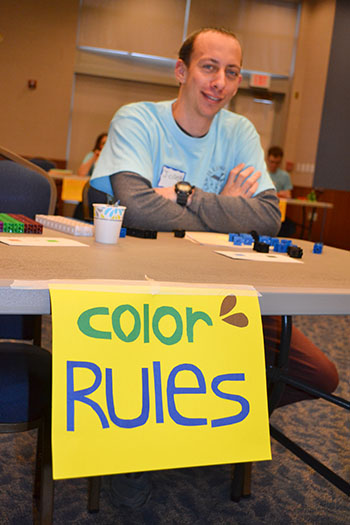 Fifth year Math PhD student Joseph Rennie mans the Color Rules game.
Fifth year Math PhD student Joseph Rennie mans the Color Rules game. A local grandmother brought her two grandkids both to do a fun activity together, but also to expose them to STEM activities that might encourage them along the STEM pipeline.
What were the kids' favorite things about the carnival, and what were some of the things they learned? Seven-year-old Ada, whose favorite activity was the Fold and Cut booth, reports: "Math is fun!" Four-year-old Hannah, whose favorite booth was Kisses and Starbursts, reports learning some things about fractals. Twelve-year-old Robert says his favorite booth was the maze. Something he learned? "Mazes are hard!" Nine-year-old David who particularly enjoyed the Color Rules booth, reports: "You can break things down to sort numbers." Ten-year-old Selene, whose favorite booth was Chocolate and Chili, reports: "Julia Robinson was very smart." And nine-year-old Simon, whose favorite booth was fractals, echoes Ada's discovery: "Math is really fun!"
Illinois math students hoped to expose youngsters to a subject they’re passionate about. For instance, Joseph Rennie, a fifth year Math PhD student who manned the Color Rules activity, shares why he wanted to be involved.
“Oh, I always like to sell math to the public or at least try to as much as possible. I think people have a really bad experience typically with mathematics in the classroom, and maybe it discourages them from thinking about math as a fun or even beautiful thing, and I think things like this are very good at kind of counteracting that. So I'm always on board.”
What impact did the organizers hope the carnival would have? Field claims that it was intended to be fun related to math, to convey to kids that “Math can be fun!”
“It's very much so going to be a very fun and exciting experience related to math,” Field explains. “And I think that that can be such a powerful experience, especially for young kids.” She indicates that lots of times as students get older, they start to lose interest in math. “Maybe it's not as cool to get excited about math,” she says, adding that, “Quite frankly, some of the things that they have to teach in the schools isn't necessarily the most exciting stuff that we get to play around with all day.” So her goal for the event was “Showing younger students that math really can be fun and exciting, and this is something that is really interesting and cool. I think that that can be such a powerful experience.”
She adds that she hopes to show them that math is something that they can be really excited about, and if they’re interested in math, “There are really cool things out there that they can get excited about and continue to be interested in.”
Hieronymi shares that they hosted the math carnival for the same reason they have always done these kind of outreach events: “It's to engage the larger Urbana-Champaign community in what we regard as fun and exciting mathematics—stuff that children don't see in school.”
He adds that the overarching goal behind their efforts is to broaden participation in mathematics. “We really want to get everyone involved. And I think and almost everyone has this talent in math, and we hope that we can show them a little bit more of what it means to be a mathematician. It's not just, let's say, computing five times six or seven times eight or something like this, but it's really solving riddles and puzzles.”
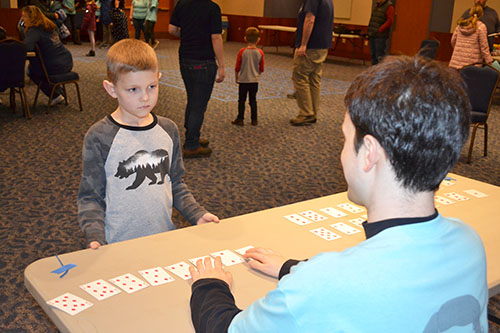 A math student interacts with a young visitor at the Fun with Sorting Algorithms game.
A math student interacts with a young visitor at the Fun with Sorting Algorithms game.Regarding the impact he hopes the carnival has on kids, Hieronymi admits: “I think there are two kinds of kids: kids that are already really into mathematics and STEM fields. And those, I hope that we foster the enthusiasm. But there are also these kids that are unsure about these kinds of fields, and those kids we also really want to reach—to try to show them why we are so excited about mathematics, that mathematics is more than what they think is mathematics.”
In fact, it’s the second group of kids—kids who think they don’t like or can’t do math that he hopes to impact down the road. “And I really hope that over the long run, as we do these events over and over again, that there are kids who, because of one of these events decided, ‘Okay, maybe I can study later on mathematics or any science, but that they really can make people consider mathematics—kids that wouldn't consider it otherwise.”
Simone shares about a connection that she didn’t make about math until she was well into graduate-level math.
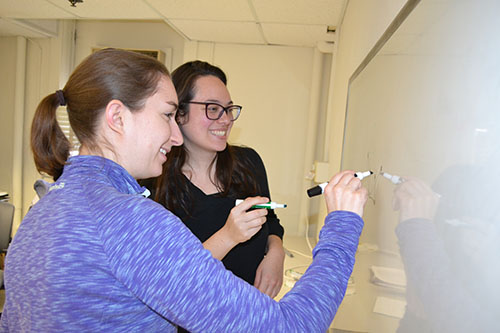 Winter Math Carnival co-coordinators: Elizabeth Field and Simone Claire Sisneros-Thiry.
Winter Math Carnival co-coordinators: Elizabeth Field and Simone Claire Sisneros-Thiry.
“As a kid,” she explains, “a lot of the games I liked to play, a lot of the puzzles I liked to do, were math. I was doing that, but I was preparing myself to do this problem solving when I got into higher-level math. But I hadn't realized that when I was 11 years old and trying to figure out how to do the Rubik's cube or I was lucky to go to outreach events at local colleges that were similar to this. And I think that being able to play those games really sort of built a foundation for me.”
Whether or not youngsters want to study math formally, she’d like kids to have an opportunity to build that foundation by playing some games that they can have positive associations with: “If you're a kid, whether or not you think you're good at math, or you think you're bad at math, whether math is something that's exciting for you or not, I think this is a place where you come, have so much fun, have really great experiences, and just walk away feeling good about being in an environment where everyone's excited about games. And really, those games are math.”
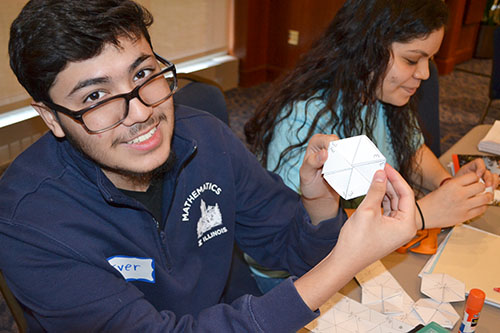
A math student shows an example of a finished Hexaflexagon.
Story and photos by Elizabeth Innes, Communications Specialist, I-STEM Education Initiative.
For additional stories about math outreach events, see:
For more related stories, see: Champaign-Urbana Community, Open House/Expo, IGL, K-6 Outreach, Math, STEM Pipeline, 2020
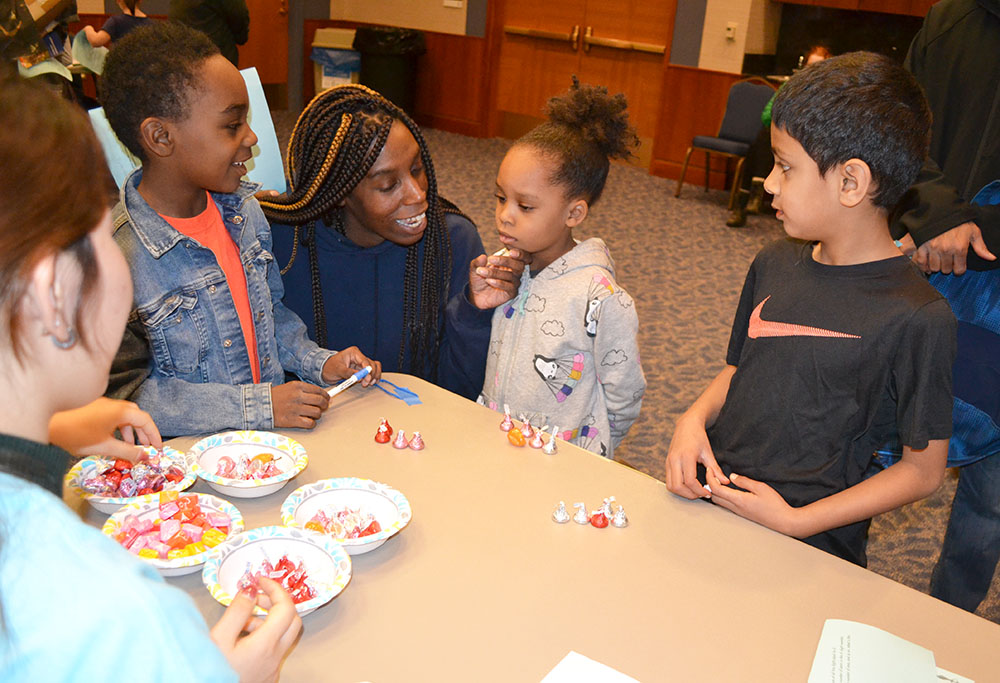 A local mom comforts her daughter who had ended up having to take the chili (which means she lost the Chocolates and Chili game).
A local mom comforts her daughter who had ended up having to take the chili (which means she lost the Chocolates and Chili game). 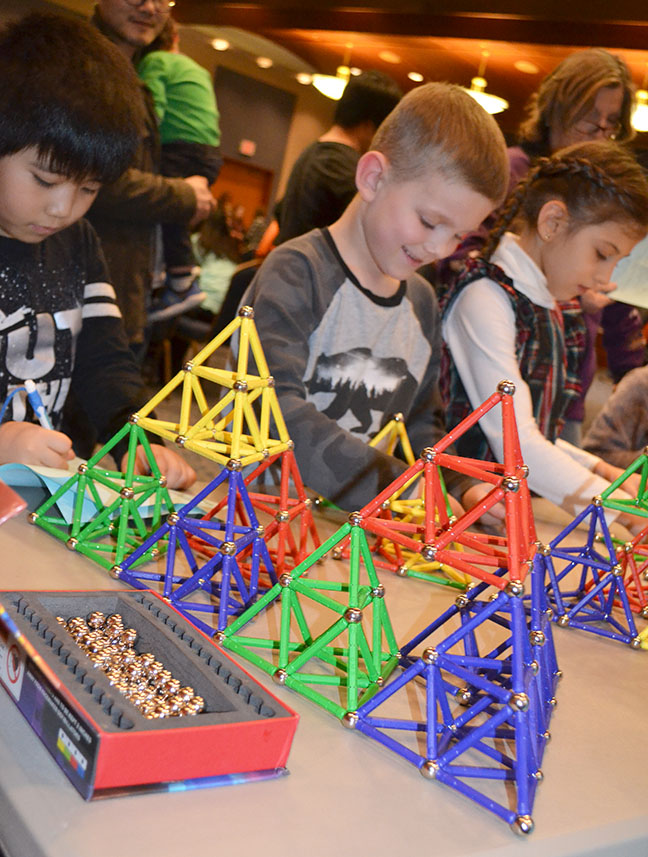
Young visitors build fractals at the Winter Math Carnival.
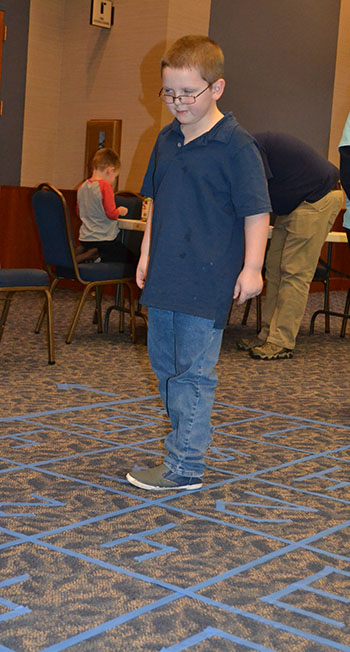 A youngster tries to decide which direction to go in the Jumping Julia game.
A youngster tries to decide which direction to go in the Jumping Julia game. 












.jpg)
















